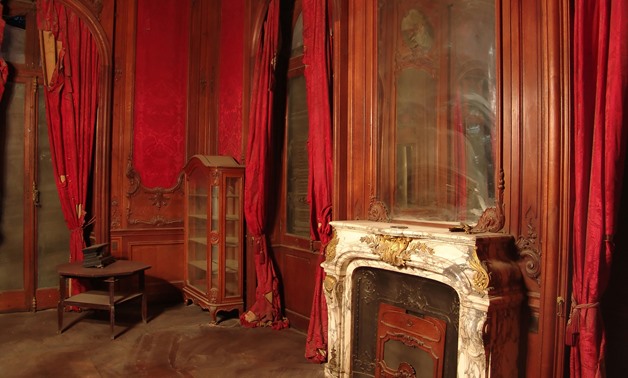
The cover of “Dust” - Photo courtesy of Xenia Nokolskaya’s seminar in Cairo
CAIRO - 13 March - 2018: Have you ever stopped by an old architectural building and decided to search for his history with the excitement of letting the people know more about it?
Due to Egypt’s rich history, it is considered to be a country that is full of architectural buildings. Although many of them became forgotten by most Egyptians, they attracted the Russian photographer to the extent that she decided to focus only on the spaces inside these buildings without photographing any people. This concept depicts the attempt of Xenia Nikolskaya, the photographer, to shed lights on these neglected places.
Xenia Nikolskaya, is Russian-Swedish photographer known for the book “Dust”, in which she successfully documents various fascinating Egyptian architectural spaces that – by time – became forgotten even by Egyptians. Nikolskaya has toured many international exhibition projects. She is a member of the Russian Artists’ Union and the former supervisor of the ROSFOTO Russian National Centre of Photography.
 Bagous Palace, Cairo, 2011,-Photo courtesy of Xenia Nokolskaya’s seminar in Cairo.
Bagous Palace, Cairo, 2011,-Photo courtesy of Xenia Nokolskaya’s seminar in Cairo.
After living in Egypt for years, Nikolskaya realized that absence in Cairo is always considered to be an extravagant opportunity that you rarely experience there. Thus, she decided to take advantage of this chance; through her photography skills she started to erase dust from many magnificent historical places.
Driven by intense curiosity, Nikolskaya said in the seminar held in Cairo on March 1, that she has faced many security and political obstacles during the photographing of both iconic and forgotten places in Egypt.
 Class room in former Prince Said Halim’s Palace, Cairo, 2007,-Photo courtesy of Xenia Nokolskaya’s seminar in Cairo.
Class room in former Prince Said Halim’s Palace, Cairo, 2007,-Photo courtesy of Xenia Nokolskaya’s seminar in Cairo.
“Dust” was completed in January2011; it includes 70 images from 30 locations in Egypt such as Cairo, Alexandria, Luxor, Minya, Esna, Port Said among others. During her accommodation in Egypt, her camera was detecting hidden architects.
She documented varied buildings in “Dust”, palaces like Bagous Palace in Cairo, Prince Said Halim’s Palace, and Sakakini Palace. As for other places: Villa Casdagli, Garden City in Cairo, Kitchen in Mahmoud Bassiouni street apartment in Cairo among other different places.
 Kitchen, Mahmoud Bassiouni street apartment, Cairo, 2010,- Photo courtesy of Xenia Nokolskaya’s seminar in Cairo.
Kitchen, Mahmoud Bassiouni street apartment, Cairo, 2010,- Photo courtesy of Xenia Nokolskaya’s seminar in Cairo.
During her latest seminar in Cairo, Nikolskaya presented a video that shows the same architectural buildings she has documented in her book before they get deteriorated by time and negligence of the responsible organizations.
“I obviously see similarities between many historical sites in my country Petersburg, and in Egypt,” Nikolskaya explained that photographing these places specifically, Nikoloskaya was deeply inspired by architects in her country.
The cover of the book is for Srageldin Palace in Garden City, as she got to go inside and communicated with relatives of the palace’s owners. The idea of this cover is that there is a layer of dust over the palace’s photograph. She was influenced by the people’s –including Egyptians- surprise when they first saw this photo for they didn’t believe that it was taken in Egypt.
 Bedroom in Hela Faris Palace,Delta, 2010,- Photo courtesy of Xenia Nokolskaya’s seminar in Cairo.
Bedroom in Hela Faris Palace,Delta, 2010,- Photo courtesy of Xenia Nokolskaya’s seminar in Cairo.
Nikolskaya brings these palaces back to life through her project. She was very careful that dust wouldn’t be completely dependent on presenting photographs about these buildings and palaces. She supports each photograph with a historical detailed brief as she wanted to portray some significant stages that Egypt passed through. That’s why she worked with architects and historians beside her photography skills.
Her works shows how in thepast decades, Egypt presented a sufficient architectural space for politicians, business people, Egyptians and foreigners. And the reason behind this is that Foreign businessmen and diplomats introduced Egypt to the European culture specially architecturally. Many of these men have been educated in several European countries then they came back to Egypt building architects with same European characteristics.
 Sakakini Palace, Cairo, 2007.- Photo courtesy of Xenia Nokolskaya’s seminar in Cairo.
Sakakini Palace, Cairo, 2007.- Photo courtesy of Xenia Nokolskaya’s seminar in Cairo.





Comments
Leave a Comment